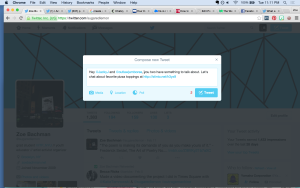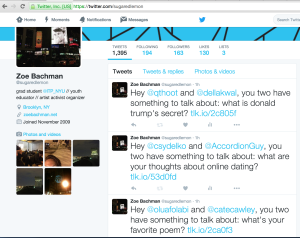Social Hacking, Assignment 2
When I first started spending time on the internet as an adolescent, I was intrigued by the possibilities of interacting in chat rooms filled with anonymous strangers or going on sites like NeoPets. The internet allowed me to meet people from all over and explore the world in a new way. Now any time I get a friend request on facebook from someone I don’t know, I delete it.
There have been plenty of think pieces about how the internet has changed. One of my favorite articles is by Hossein Derakhshan, an Iranian blogger I came across during my undergraduate research. In his piece, he discusses how the internet has shifted from being decentralized and expansive to the stream, akin to a TV.
We’re increasingly siloing ourselves online. Rather than approach the internet as a space to be explored, we pick and choose and consume what we think (or the algorithms tell us) is best. To quote Derakhshan, “The web was not envisioned as a form of television when it was invented. But, like it or not, it is rapidly resembling TV: linear, passive, programmed and inward-looking.” Most often, feeds are full of people who share the same ideas, life-experiences and values. Its very common to see people post that they will unfriend those who share dissenting thoughts.
In not getting exposure to alternate experiences and modes of thought, do we risk increasing the differences amongst us, possible leading to greater conflict IRL?
Participating in diverse environments is hella important. Science backs it up! Because all this made me think…if we know diversity is better for us, why don’t we build that into our online experiences?
I was talking to a friend about this and he said something that resonated, “Humans want to be around people who make us feel better.”
And I thought, sure, I can agree with that. I tend to feel more comfortable around people I know and who have had similar life experiences…but, I also know that if I hadn’t reached beyond those small communities, I would have never formed very important relationships, or collaborated on awesome projects, or simply learned new things. It’s important for us as humans to challenge our self-made and imposed socio-cultural boundaries. How can we actively engage possibly in an uncomfortable but ultimately beneficial way online?
————————————–
What would it mean to intentionally bring people who might not otherwise “meet” online into the same space? What if these people were not only different, but held completely opposite views?
Been thinking a lot about subjectivity and Lacan’s mirror theory: that we constitute subjectivity in relation to an other – we know what we are because of what we are not.
I wanted to construct an experience that brings together people on social media platforms who might not come across each other or choose to interact. To create a moment and space that breaks down divisions and see what possibilities emerge when two people are randomly thrown together.
How does one break out of conscripted online social experiences? Chat rooms were the place to be anonymous and meet anyone from around the world, so could this kind of online space be brought back in intentional way?
[I’m still figuring out some tech stuff, but Kyle made the point that before one creates an automated experience, there’s a lot of manual work to be done. So this project is an early iteration and experiment of a future automated process.]I wrote tweets from my personal account that mentioned two random people on twitter and invite them to chat on a specific topic.
After messing around at first, I came up with a few different variations:
Experiment A: mentioning both users in tweets, inviting to join chat in tweet
Experiment Av1:
Two random people
Random subject
Experiment Av2:
Two people from same search query
Random subject
Experiment Av3:
Two people from same search query
Subject related to search query
I made a spreadsheet to keep track of the interactions and chat rooms, which you can look at here: https://docs.google.com/spreadsheets/d/1aGoiU4rTUmmeO-Icfx0cIp9issAFQLRufns7sSaVilA/edit?usp=sharing
It was more challenging than I expected to find “random” people to use. Twitter kept wanting to feed me big name brands and celebrity users. Even when searching for a random topic there was a hierarchy of tweets with brands and celebrities first, then those who I follow or who my friends follow.
Once I found my two people, I’d come up with a random topic for them to talk about. I’d tweet, “Hey @… and @…, I think you two would have something to talk about. Let’s chat about [topic] at this [url]”
Then I’d create a chat using the tlk.io free chat app, post the topic at the top and wait.
I brainstormed a list of random topics, bouncing from the banal to the inflammatory, the absurd and sincere.
TOPICS:
your favorite pizza toppings
your feelings about Beyoncé’s new music video
this picture of a sloth
Bernie Sander’s viability as a candidate
your childhood neighborhood
first computer game
universal health care
student loan debt
the prison industrial complex
what was the coolest cloud shape that you ever saw
what your first screen name was
current favorite song
what city you want to visit the most in the world and why
what you love most about where you’re from
best sandwich
online dating
I wrote 15 tweets, but so far no bites. I guess I’m not totally surprised, though really wishing that someone will be curious and see what this is all about.
————————————-
FROM HERE
– What can be changed about this experience so that people will actively engage?
– How can this be automated? Would it have the same effect if it was?
– What could this look like on a larger scale, involving more than two people?
– Is it possible to recreate “chance” encounters online? How much control over our social lives is good?
Edit: recently found out about the practice of “uncomfortable design” that I think would figure well into this discussion. Nicholas Hubbard posted this article in the NYU ITP facebook group. A quote that I thought spoke to this project was:
Our last form of discomfort concerns intimacy. Computers are increasingly mediating our social experiences which gives rise to the possibility of distorting normal social relations in uncomfortable ways, for example isolating people (used in both Breathless and Ulrike and Eamon Compliant), employing surveillance and voyeurism (also used in both), and establishing unusual intimacy with strangers.
Oh, also just found this Pew Research Center Report on different types of networks that exist on twitter, from the polarized (what this project is interested in) to tight crowds and brand clusters. The report says that while two groups of people can talking about the same subject, their language, links and conversation can be completely opposite.


